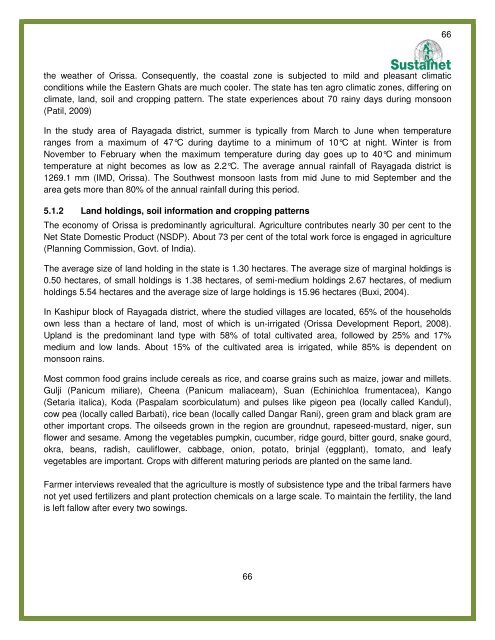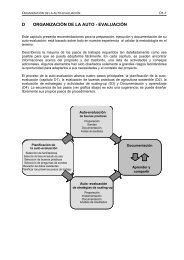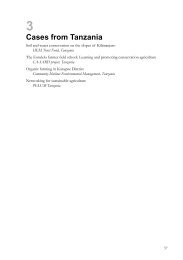Adaptation of small scale farmers to climatic risks in India - Sustainet
Adaptation of small scale farmers to climatic risks in India - Sustainet
Adaptation of small scale farmers to climatic risks in India - Sustainet
You also want an ePaper? Increase the reach of your titles
YUMPU automatically turns print PDFs into web optimized ePapers that Google loves.
the weather <strong>of</strong> Orissa. Consequently, the coastal zone is subjected <strong>to</strong> mild and pleasant <strong>climatic</strong><br />
conditions while the Eastern Ghats are much cooler. The state has ten agro <strong>climatic</strong> zones, differ<strong>in</strong>g on<br />
climate, land, soil and cropp<strong>in</strong>g pattern. The state experiences about 70 ra<strong>in</strong>y days dur<strong>in</strong>g monsoon<br />
(Patil, 2009)<br />
In the study area <strong>of</strong> Rayagada district, summer is typically from March <strong>to</strong> June when temperature<br />
ranges from a maximum <strong>of</strong> 47°C dur<strong>in</strong>g daytime <strong>to</strong> a m<strong>in</strong>imum <strong>of</strong> 10°C at night. W<strong>in</strong>ter is from<br />
November <strong>to</strong> February when the maximum temperature dur<strong>in</strong>g day goes up <strong>to</strong> 40°C and m<strong>in</strong>imum<br />
temperature at night becomes as low as 2.2°C. The average annual ra<strong>in</strong>fall <strong>of</strong> Rayagada district is<br />
1269.1 mm (IMD, Orissa). The Southwest monsoon lasts from mid June <strong>to</strong> mid September and the<br />
area gets more than 80% <strong>of</strong> the annual ra<strong>in</strong>fall dur<strong>in</strong>g this period.<br />
5.1.2 Land hold<strong>in</strong>gs, soil <strong>in</strong>formation and cropp<strong>in</strong>g patterns<br />
The economy <strong>of</strong> Orissa is predom<strong>in</strong>antly agricultural. Agriculture contributes nearly 30 per cent <strong>to</strong> the<br />
Net State Domestic Product (NSDP). About 73 per cent <strong>of</strong> the <strong>to</strong>tal work force is engaged <strong>in</strong> agriculture<br />
(Plann<strong>in</strong>g Commission, Govt. <strong>of</strong> <strong>India</strong>).<br />
The average size <strong>of</strong> land hold<strong>in</strong>g <strong>in</strong> the state is 1.30 hectares. The average size <strong>of</strong> marg<strong>in</strong>al hold<strong>in</strong>gs is<br />
0.50 hectares, <strong>of</strong> <strong>small</strong> hold<strong>in</strong>gs is 1.38 hectares, <strong>of</strong> semi-medium hold<strong>in</strong>gs 2.67 hectares, <strong>of</strong> medium<br />
hold<strong>in</strong>gs 5.54 hectares and the average size <strong>of</strong> large hold<strong>in</strong>gs is 15.96 hectares (Buxi, 2004).<br />
In Kashipur block <strong>of</strong> Rayagada district, where the studied villages are located, 65% <strong>of</strong> the households<br />
own less than a hectare <strong>of</strong> land, most <strong>of</strong> which is un-irrigated (Orissa Development Report, 2008).<br />
Upland is the predom<strong>in</strong>ant land type with 58% <strong>of</strong> <strong>to</strong>tal cultivated area, followed by 25% and 17%<br />
medium and low lands. About 15% <strong>of</strong> the cultivated area is irrigated, while 85% is dependent on<br />
monsoon ra<strong>in</strong>s.<br />
Most common food gra<strong>in</strong>s <strong>in</strong>clude cereals as rice, and coarse gra<strong>in</strong>s such as maize, jowar and millets.<br />
Gulji (Panicum miliare), Cheena (Panicum maliaceam), Suan (Ech<strong>in</strong>ichloa frumentacea), Kango<br />
(Setaria italica), Koda (Paspalam scorbiculatum) and pulses like pigeon pea (locally called Kandul),<br />
cow pea (locally called Barbati), rice bean (locally called Dangar Rani), green gram and black gram are<br />
other important crops. The oilseeds grown <strong>in</strong> the region are groundnut, rapeseed-mustard, niger, sun<br />
flower and sesame. Among the vegetables pumpk<strong>in</strong>, cucumber, ridge gourd, bitter gourd, snake gourd,<br />
okra, beans, radish, cauliflower, cabbage, onion, pota<strong>to</strong>, br<strong>in</strong>jal (eggplant), <strong>to</strong>ma<strong>to</strong>, and leafy<br />
vegetables are important. Crops with different matur<strong>in</strong>g periods are planted on the same land.<br />
Farmer <strong>in</strong>terviews revealed that the agriculture is mostly <strong>of</strong> subsistence type and the tribal <strong>farmers</strong> have<br />
not yet used fertilizers and plant protection chemicals on a large <strong>scale</strong>. To ma<strong>in</strong>ta<strong>in</strong> the fertility, the land<br />
is left fallow after every two sow<strong>in</strong>gs.<br />
66<br />
66




